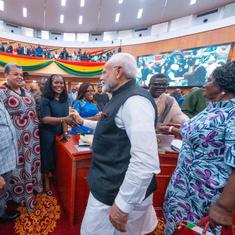The Big Story:
Whether or not he has the Nobel Peace Prize in mind, the Art of Living founder Ravi Shankar, known to his followers as Sri Sri, has waded forth into the muddled waters of the Babri Masjid dispute in Ayodhya. With barely weeks to go before the Supreme Court is set to start day-to-day hearings in the case, Shankar has decided that he will try to meet all of the stakeholders in the matter and attempt to come up with an out-of-court solution. As things stand, the site of the land, which saw Hindutva mobs demolish a centuries-old mosque in 1992, had been divided by the Allahabad High Court in 2010, with one-third of it going to each Ram Lalla – or Infant Rama represented by the Hindu Maha Sabha for the construction of the Ram temple – as well as the Sunni Waqf Board and the Nirmohi Akhara, a Hindu organisation.
Shankar has spent the last few days meeting people in Ayodhya and making pronouncements about the matter. He said that the “youth and leaders of the communities” can find a solution to the matter. He insisted that Muslims “by and large” were not opposed to a temple on the site. And he insisted that even if the Supreme Court does come up with a solution, the dispute over the site may flare up again, and so it is important for spiritual and religious leaders to help negotiate a settlement. He even met with Uttar Pradesh Chief Minister Adityanath right before setting out on his negotiation talks, giving his effort the veneer of legitimacy even if the UP government said it was not a party to his plan.
Not everyone is on board, as is to be expected in a matter that has been festering for more than half a century. Vishwa Hindu Parishad leader Ram Vilas Vedanti was the most direct about his response, saying Shankar had never been part of the movement and was trying to negotiate to divert focus from a “huge foreign donation” he recently received. Narendra Giri of the All India Akhara Parishad said Shankar is “enacting a drama.” The plaintiffs Iqbal Ansari and Haji Mahboob both said they would wait for the Supreme Court order, even though they met Shankar. And Mahant Gyan Das, head of the Hanumanghari temple in Ayodhya, said that Shankar had scotched an earlier negotiated settlement that was almost agreed upon.
India Today TV claims Shankar has gone further. It reported on Thursday on an alleged secret deal between Shankar and the Nirmohi Akhara, one of the three stakeholders, claiming the Art of Living founder was offering to give money to the Sunni Waqf board, via the Akhara, in return for its share of the land.
The timing here is particularly curious. The dispute has been simmering for decades now. The Supreme Court hearing has been pending for seven years. And suddenly now, right before the Supreme Court is set to take up the case on a day-to-day basis – with Gujarat elections also around the corner – Ravi Shankar has decided to jump into the fray. Adityanath’s decision to meet him also seemed to send a message of approval, even if he himself insisted that nothing was likely to come out of Shankar’s talks.
Amid all this, and especially with the press covering Shankar’s comments about ‘youth’ and ‘Muslims by and large’ willing to come to a settlement, it is important to remember this is a property dispute. The Allahabad High Court may have justified the criminal destruction of the mosque by a Hindutva mob by giving part of the land to Hindu organisations simply on the basis of faith, but the Supreme Court still has to examine exactly the contours of the law here. Sentiments of the people should not matter, especially if that becomes a fig-leaf for the majority to bully the minority, a definite danger in a state ruled by a chief minister accused of instigating religious riots.
While attempts at brokering peace may be a good thing, Shankar’s efforts seem belated and, if the India Today TV report is to be believed, possibly underhand. Coming so soon before the court hearing and a charged election as well, they have the possible to add fuel to a fire that has been simmering for years now. The Art of Living founder may be right when he claims that however the Supreme Court decides, the dispute may continue to fester, but if last-minute offers of money are his solution, Ayodhya seems better placed waiting for the apex court to hear the matter.
The Big Scroll
- The Babri Masjid dispute does not need an ‘amicable solution’ – it needs justice, writes Shoaib Daniyal.
- Should the ‘collective conscience’ override the spirit of the Constitution, asks TM Krishna.
- What Babri offer means: Compelling Muslims to accept the guilt for temples converted into mosques, writes Ajaz Ashraf.
- Why is the Supreme Court reluctant to pronounce verdict on a property dispute, asks Girish Shahane.
Subscribe to “The Daily Fix” by either downloading Scroll’s Android app or opting for it to be delivered to your mailbox. For the rest of the day’s headlines do click here.
If you have any concerns about our coverage of particular issues, please write to the Readers’ Editor at readerseditor@scroll.in
Punditry
- “The Supreme Court is definitely facing an institutional crisis of the kind that it has never faced before, mainly, but not exclusively, on account of the most ferocious attack ever on the judiciary by the executive,” writes Colin Gonsalves in the Hindu.
- Shefalee Vasudev in the Indian Express takes apart a misguided article in the New York Times, which suggests that the sari has become a symbol of Hindu nationalism.
- Sadanand Dhume in the Wall Street Journal writes of communism’s “long shadow over India.”
- “The government is set to unveil the first New Education Policy in 25 years in December 2017. It needs to address the key concerns and should focus on equity in quality—ensuring universal access to free, quality, equitable and safe public education for all of India’s young citizens,” writes Anjela Taneja in Mint.
- Banwari Lal and K Nanthakumar in Hindu Businessline call for a multi-disciplinary response to the alarming threat of anti-microbial resistance.
Giggle
THE NIGHTMARE. @timesofindia #GujaratElections pic.twitter.com/2SfzoYowPH
— Sandeep Adhwaryu (@CartoonistSan) November 16, 2017
Don’t miss
Tanuja Kothiyal traces the history of stories about Rani Padmini, from Rajasthan to Bollywood via Bengal.
In the early nineteenth century, it was James Tod, the Scottish annalist of Rajputana, through whose Annals Padmini became a part of Mewar’s history. Tod’s Annals were based both on manuscripts that he collected as well as bardic accounts that he heard and translated.
In Tod’s account, Padmini becomes the daughter of Hamir Sank of Ceylon and the wife of Bhim Singh of Mewar. Though the plot line remains much the same, in Tod’s account, the tale of Padmini becomes a part of the historical recollection of the Mewar line, often to be read and quoted as history in the future.
Tod was a romantic, someone who equated the Rajputs of Rajasthan with the Anglo-Saxon knights, with valour and chivalry as the inherent virtues. In his telling of Padmini’s narrative, the honourable Rajput faces defeat due to deceitful tactics of the Muslim sultan, a trope that dominates his entire Annals.










